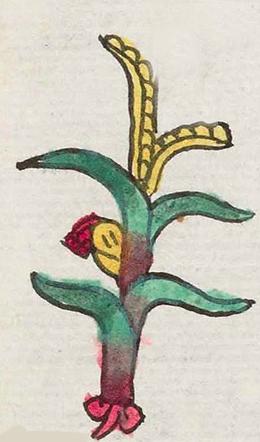ohuatl (Mdz37r)
This element emphasizing a green maize stalk (ohuatl) has been carved from the compound sign for the place name, Ohuapan. As can be seen below, right, the flag (pantli or panitl) has been removed. The visual of this ohuatl is of a full grown plant, not only flowering by with an ear of corn. The stalk and leaves are green, the roots (visible above the ground) are red, and the maize cob is yellow with a red tassel. The corn has two parallel black hash marks and one additional black line, which might be unintended.
Stephanie Wood
The two hash marks on the corn cob have the look of two eyes, which would anthropomorphize the plant. Corn cobs in mural paintings in Cacaxtla have cobs that are made into human heads. But another interpretation here is that the pairs of parallel short lines that appear on these maize ears are diagnostic marks that say "maize." Note how, on the corn tortillas that appear below, these same parallel lines appears. They are thinner than the "hua" syllable hash marks, and yet ohuatl contains "hua" so perhaps that is the source of the two parallel vertical lines that appear on corncobs and tortillas.
Perhaps we should add the "'hua' syllable from ohuatl" to our syntax list of phonetic syllables. Except that with various forms of maize, such as the tortilla and the cobs that have what appear to be faces, the glyph is not always standing for a vocabulary word that contains hua. See, for example, Atocpan (Mdz29r), Teocinyocan (Mdz49r), and Chinantlan (Mdz46r).
Speaking of faces, Lois Martin and Chantal Huckert refer to "dimples" on maize kernels that indicate that it is time to pick the cobs and store them. [James Maffie brought this to my attention in a personal communication, 3/4/2025. He cites: Lois Martin, “The Axochiatl Pattern: Aztec Science, Legitimacy, and Cross-Dressing,” in Visual Culture of the Ancient Americas: Contemporary Perspectives, Andrew Finegold and Ellen Hoobler (eds). Norman: University of Oklahoma Press, 2017, pp. 197-208.] Maffies adds that the personification of maize cobs, "supports the idea that maize ears (and kernels) are animate, other-than-human persons (an idea for which we already have tons of supporting evidence)."
Stephanie Wood
c. 1541, or by 1553 at the latest
Stephanie Wood
plantas de maíz, milpa, tallo, caña de maíz

ohua(tl), green maize stalk, https://nahuatl.wired-humanities.org/content/ohuatl
la planta del maíz
Stephanie Wood
Codex Mendoza, folio 37 recto, https://digital.bodleian.ox.ac.uk/objects/2fea788e-2aa2-4f08-b6d9-648c00..., image 84 of 188.
The Bodleian Libraries, University of Oxford, hold the original manuscript, the MS. Arch. Selden. A. 1. This image is published here under the UK Creative Commons, “Attribution-NonCommercial-ShareAlike 3.0 License” (CC-BY-NC-SA 3.0).



